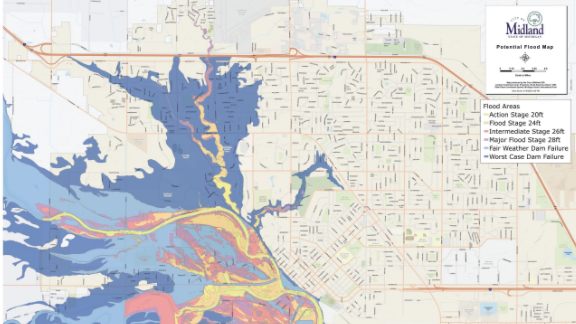Two Dams Fail In Michigan, Watch Them Break As Cities Are Flooded
Both the Edenville Dam and the Sanford Dam suffered catastrophic failures, causing the Tittabawassee to hit record levels.
This article is more than 2 years old

The state of Michigan is no stranger to catastrophe. Flint, Michigan and their tainted water supply immediately come to mind. Now they can count the town of Midland as part of their catastrophic history as two dams along the Tittabawassee River in central Michigan were breached.
Widespread rainfall earlier in the week had pushed many river levels to near capacity prompting the Weather Service to issue flood warnings. Sadly, these warnings turned into reality for the nearly 10,000 inhabitants located around Midland. The Weather Service also urged those residents to seek higher ground as both the Edenville Dam and the Sanford Dam suffered catastrophic failures, causing the Tittabawassee to hit record levels. On Tuesday night, the river was at 30.5 feet. Flood stage for the river is 24 feet. By Wednesday morning, the river had risen another four feet, bringing it to the new record of 34.4 feet. It bested the previous 1986 record of 33.9 feet.
Photos And Video From The Disaster
Government Response To The Michigan Flooding
Michigans Governor Gretchen Whitmer, who has been under recent massive fire with her continuing stay-at-home orders, declared a state of emergency for Midland County and warned that downtown Midland, which is a city of approximately 42,000 and located 8 miles downstream of the Stanford Dam, will face a serious and unprecedented flood threat. “In the next 12 to 15 hours, downtown Midland could be under approximately 9 feet of water,” the governor said. “We are anticipating an historic high-water level.”
According to Midland spokeswoman Selina Crosby Tisdale there have been, thankfully, no deaths reported. The battle the county is facing is where to house those displaced and for how long. With the worst of the flood still to be seen, it’s anyone’s guess. “We’re still waiting to crest, and then we have to wait for water levels to recede. It’s going to take days until we get to that point,” Tisdale said. The expectation is that the river will crest at 38 feet.
Obviously, another concern county and state officials are facing is dealing with the pandemic at the same time. Tisdale did say that workers at the recently put together shelters are checking temperatures and handing out masks to all evacuees. Whitmer even made her plea at a Tuesday night news conference. “Please, to the best of your ability, continue to wear a face-covering when you go to a shelter or go stay with a friend or relative.”
This catastrophe wouldn’t be what it is, though, without some controversy. The Edenville Dam, built in 1924 and houses a hydropower project, had its license revoked by federal regulators after warning for not one, but two decades, that it was vulnerable to significant flooding. Let’s stress that, TWO decades. Boyce Hydro Power purchased Edenville Dam in 2004, unwilling to make the necessary improvements. The state finally rated it as unsatisfactory in 2018 after an order from the Federal Regulatory Commission in 2017 stating in part, “Given Edenville dam’s high hazard potential rating, the potential loss of life and destruction of property and infrastructure is grave should the project not be maintained and operated appropriately, with consequences that could certainly affect the village of Sanford, Northwood University, city of Midland, Michigan, and other areas downstream.” The Commission pointed out that the dam’s spillway was their major concern. “(Boyce) failed to increase the capacity of spillways to enable them to pass the probable maximum flood (PMF) as required by Regional Engineer directives.” They also warned further that “failure of the Edenville dam could result in the loss of human life and the destruction of property and infrastructure.” In response to having their license revoked, the Detroit News reported Boyce Hydro argued that the “odds of a ‘probable maximum flood’ event occurring in the next 5 to 10 years is 5 to 10 in one million.”
This story is on-going.












